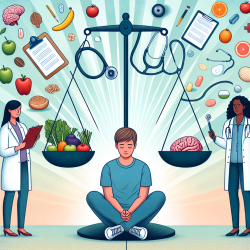Introduction
Atypical Anorexia Nervosa (AAN) presents a unique challenge for healthcare providers, especially those working with adolescents. Unlike traditional Anorexia Nervosa (AN), individuals with AAN maintain a weight within or above the normal range despite experiencing significant weight loss and severe malnutrition. This distinction often leads to delayed diagnosis and treatment, as many healthcare providers are trained to recognize eating disorders primarily through low body weight.
Understanding Atypical Anorexia Nervosa
AAN is characterized by the same restrictive eating behaviors and psychological symptoms as AN, including an intense fear of gaining weight and a distorted body image. However, the individuals affected may not appear underweight, which complicates the diagnosis. Research indicates that those with a history of overweight or obesity are particularly at risk, and the prevalence of AAN is increasing, especially during the COVID-19 pandemic.
Key Findings from Recent Research
According to the review article "Atypical Anorexia in Youth: Cautiously Bridging the Treatment Gap," there is an urgent need for standardized guidelines to effectively diagnose and treat AAN in youths. The lack of consensus on treatment outcomes, such as weight goals, further complicates the situation. The article suggests that a greater understanding of AAN is essential for informed medical decisions and effective psychological therapy.
Implications for Practitioners
Healthcare providers should consider the following strategies to improve diagnosis and treatment of AAN:
- Comprehensive Assessment: Conduct thorough medical and psychiatric evaluations, including a detailed weight history and assessment of eating disorder symptoms, regardless of the patient's current weight.
- Early Intervention: Recognize the importance of early diagnosis and intervention to prevent the progression of AAN to more severe eating disorders.
- Weight-Neutral Approach: Adopt a weight-neutral stance in conversations about health and nutrition to avoid stigmatizing language and focus on overall well-being rather than weight alone.
- Family-Based Treatment: Implement family-based treatment (FBT) as a first-line approach, empowering caregivers to support their child's recovery.
- Ongoing Research: Encourage further research to develop concrete medical guidelines and psychiatric interventions for AAN, considering diverse clinical populations.
Conclusion
Addressing AAN requires a shift in perspective from healthcare providers, recognizing that rapid weight loss and malnutrition, not appearance, are indicative of the illness's severity. By implementing evidence-based practices and encouraging further research, practitioners can bridge the treatment gap and improve outcomes for youths with AAN.
To read the original research paper, please follow this link: Atypical Anorexia in Youth: Cautiously Bridging the Treatment Gap.










